NRSG355 Clinical Integration Assignment: Modules 1-4 Analysis
VerifiedAdded on 2023/06/04
|10
|2814
|369
Homework Assignment
AI Summary
This assignment solution addresses key aspects of nursing practice, encompassing modules on prioritization, delegation, collaborative and therapeutic practice, provision and coordination of care, and time management. It analyzes case studies to evaluate clinical scenarios, focusing on patient allocation, the scope of practice for different staff roles, and efficient time management strategies within a healthcare setting. The document explores the importance of team nursing, effective communication, and the delegation of responsibilities among healthcare professionals. The solution emphasizes the importance of ethical nursing care, patient assessment, and the need for critical thinking in addressing complex patient needs. References are included to support the claims and analyses presented in the assignment.
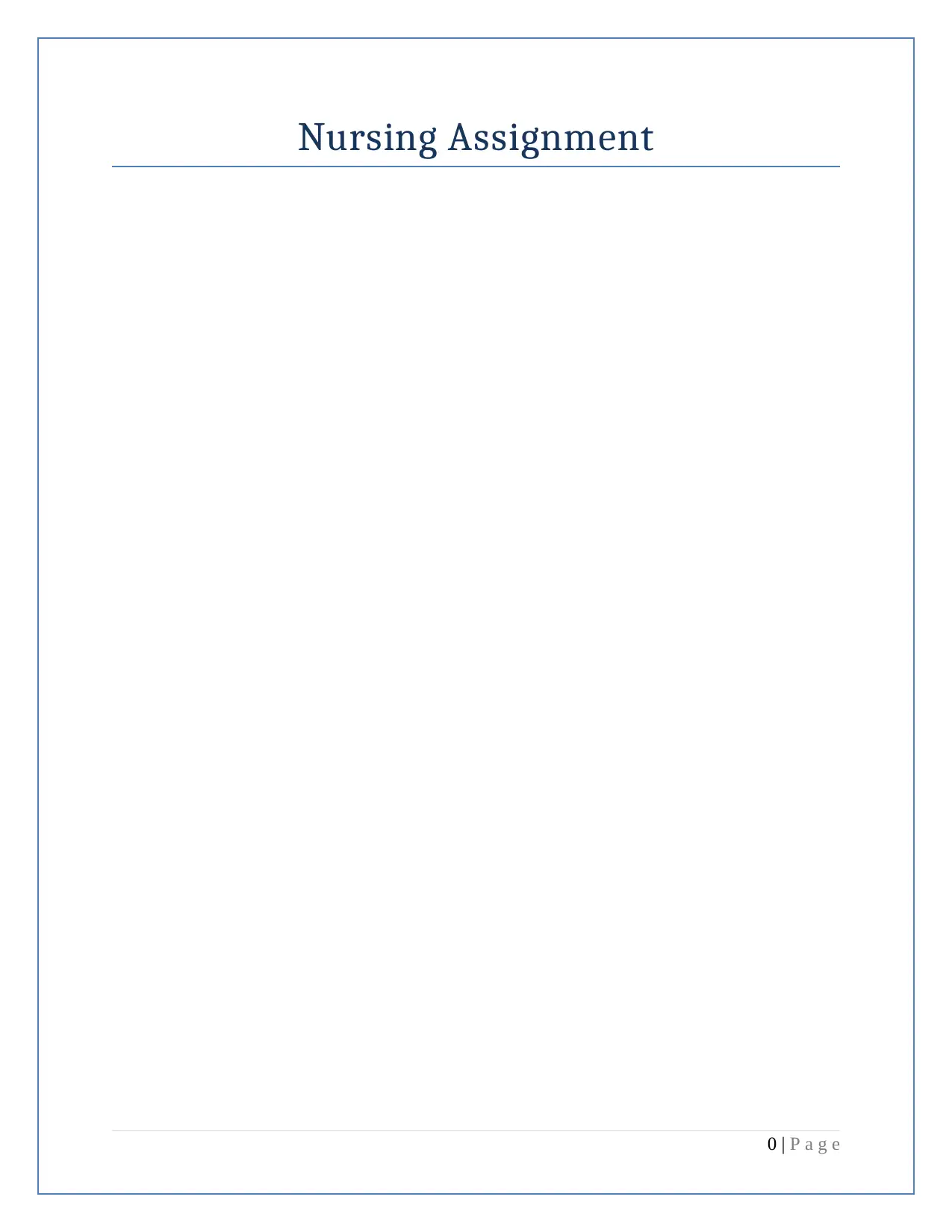
Nursing Assignment
0 | P a g e
0 | P a g e
Paraphrase This Document
Need a fresh take? Get an instant paraphrase of this document with our AI Paraphraser
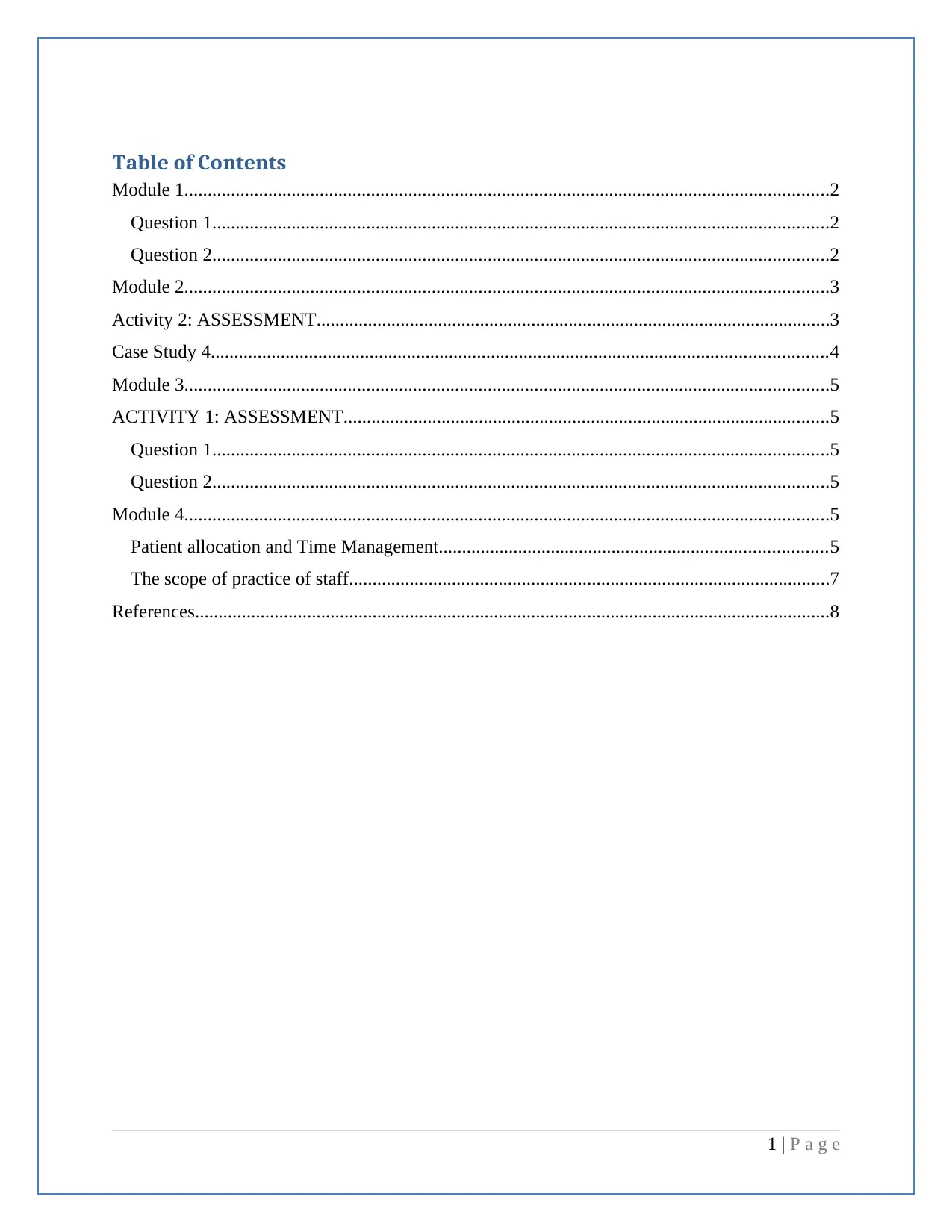
Table of Contents
Module 1..........................................................................................................................................2
Question 1....................................................................................................................................2
Question 2....................................................................................................................................2
Module 2..........................................................................................................................................3
Activity 2: ASSESSMENT..............................................................................................................3
Case Study 4....................................................................................................................................4
Module 3..........................................................................................................................................5
ACTIVITY 1: ASSESSMENT........................................................................................................5
Question 1....................................................................................................................................5
Question 2....................................................................................................................................5
Module 4..........................................................................................................................................5
Patient allocation and Time Management...................................................................................5
The scope of practice of staff.......................................................................................................7
References........................................................................................................................................8
1 | P a g e
Module 1..........................................................................................................................................2
Question 1....................................................................................................................................2
Question 2....................................................................................................................................2
Module 2..........................................................................................................................................3
Activity 2: ASSESSMENT..............................................................................................................3
Case Study 4....................................................................................................................................4
Module 3..........................................................................................................................................5
ACTIVITY 1: ASSESSMENT........................................................................................................5
Question 1....................................................................................................................................5
Question 2....................................................................................................................................5
Module 4..........................................................................................................................................5
Patient allocation and Time Management...................................................................................5
The scope of practice of staff.......................................................................................................7
References........................................................................................................................................8
1 | P a g e
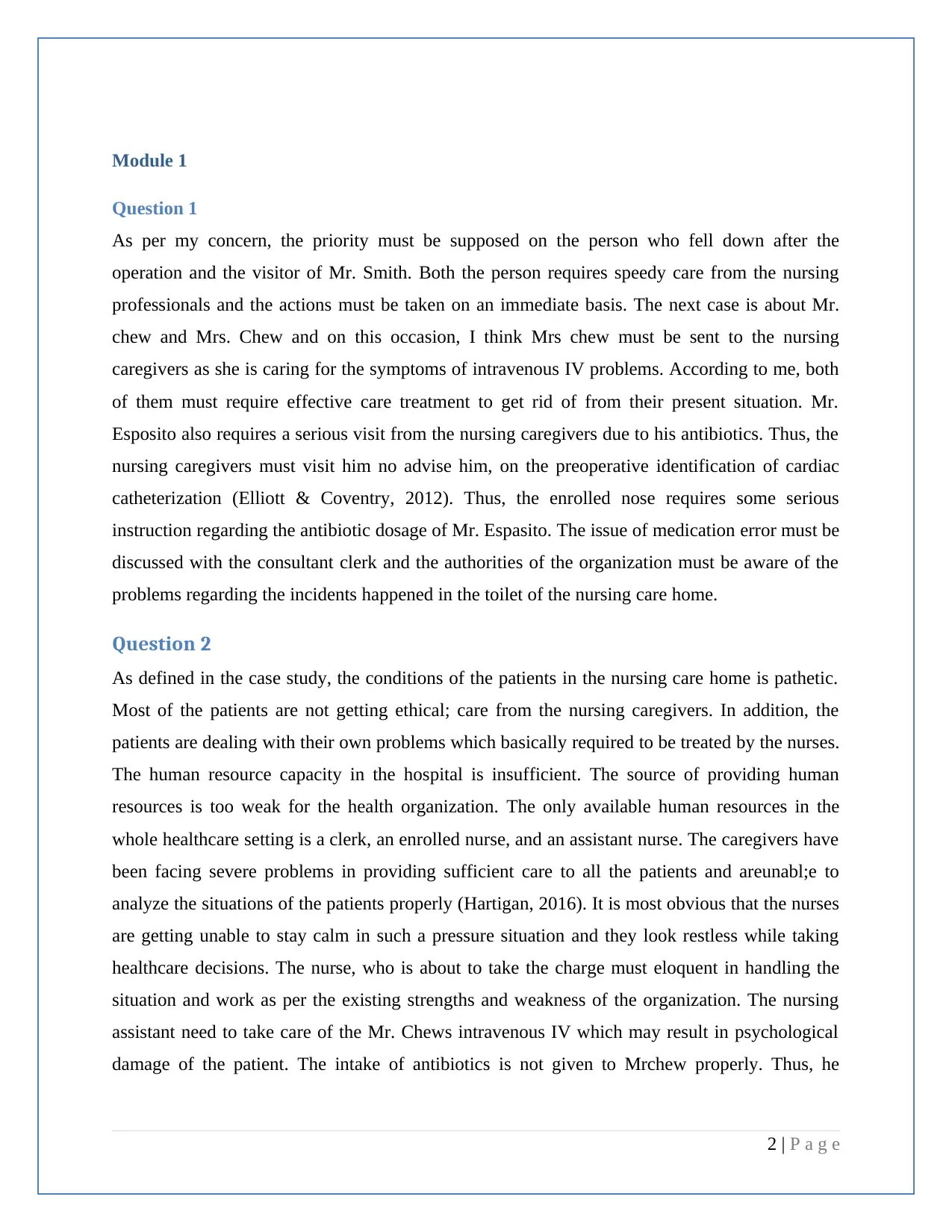
Module 1
Question 1
As per my concern, the priority must be supposed on the person who fell down after the
operation and the visitor of Mr. Smith. Both the person requires speedy care from the nursing
professionals and the actions must be taken on an immediate basis. The next case is about Mr.
chew and Mrs. Chew and on this occasion, I think Mrs chew must be sent to the nursing
caregivers as she is caring for the symptoms of intravenous IV problems. According to me, both
of them must require effective care treatment to get rid of from their present situation. Mr.
Esposito also requires a serious visit from the nursing caregivers due to his antibiotics. Thus, the
nursing caregivers must visit him no advise him, on the preoperative identification of cardiac
catheterization (Elliott & Coventry, 2012). Thus, the enrolled nose requires some serious
instruction regarding the antibiotic dosage of Mr. Espasito. The issue of medication error must be
discussed with the consultant clerk and the authorities of the organization must be aware of the
problems regarding the incidents happened in the toilet of the nursing care home.
Question 2
As defined in the case study, the conditions of the patients in the nursing care home is pathetic.
Most of the patients are not getting ethical; care from the nursing caregivers. In addition, the
patients are dealing with their own problems which basically required to be treated by the nurses.
The human resource capacity in the hospital is insufficient. The source of providing human
resources is too weak for the health organization. The only available human resources in the
whole healthcare setting is a clerk, an enrolled nurse, and an assistant nurse. The caregivers have
been facing severe problems in providing sufficient care to all the patients and areunabl;e to
analyze the situations of the patients properly (Hartigan, 2016). It is most obvious that the nurses
are getting unable to stay calm in such a pressure situation and they look restless while taking
healthcare decisions. The nurse, who is about to take the charge must eloquent in handling the
situation and work as per the existing strengths and weakness of the organization. The nursing
assistant need to take care of the Mr. Chews intravenous IV which may result in psychological
damage of the patient. The intake of antibiotics is not given to Mrchew properly. Thus, he
2 | P a g e
Question 1
As per my concern, the priority must be supposed on the person who fell down after the
operation and the visitor of Mr. Smith. Both the person requires speedy care from the nursing
professionals and the actions must be taken on an immediate basis. The next case is about Mr.
chew and Mrs. Chew and on this occasion, I think Mrs chew must be sent to the nursing
caregivers as she is caring for the symptoms of intravenous IV problems. According to me, both
of them must require effective care treatment to get rid of from their present situation. Mr.
Esposito also requires a serious visit from the nursing caregivers due to his antibiotics. Thus, the
nursing caregivers must visit him no advise him, on the preoperative identification of cardiac
catheterization (Elliott & Coventry, 2012). Thus, the enrolled nose requires some serious
instruction regarding the antibiotic dosage of Mr. Espasito. The issue of medication error must be
discussed with the consultant clerk and the authorities of the organization must be aware of the
problems regarding the incidents happened in the toilet of the nursing care home.
Question 2
As defined in the case study, the conditions of the patients in the nursing care home is pathetic.
Most of the patients are not getting ethical; care from the nursing caregivers. In addition, the
patients are dealing with their own problems which basically required to be treated by the nurses.
The human resource capacity in the hospital is insufficient. The source of providing human
resources is too weak for the health organization. The only available human resources in the
whole healthcare setting is a clerk, an enrolled nurse, and an assistant nurse. The caregivers have
been facing severe problems in providing sufficient care to all the patients and areunabl;e to
analyze the situations of the patients properly (Hartigan, 2016). It is most obvious that the nurses
are getting unable to stay calm in such a pressure situation and they look restless while taking
healthcare decisions. The nurse, who is about to take the charge must eloquent in handling the
situation and work as per the existing strengths and weakness of the organization. The nursing
assistant need to take care of the Mr. Chews intravenous IV which may result in psychological
damage of the patient. The intake of antibiotics is not given to Mrchew properly. Thus, he
2 | P a g e
⊘ This is a preview!⊘
Do you want full access?
Subscribe today to unlock all pages.

Trusted by 1+ million students worldwide
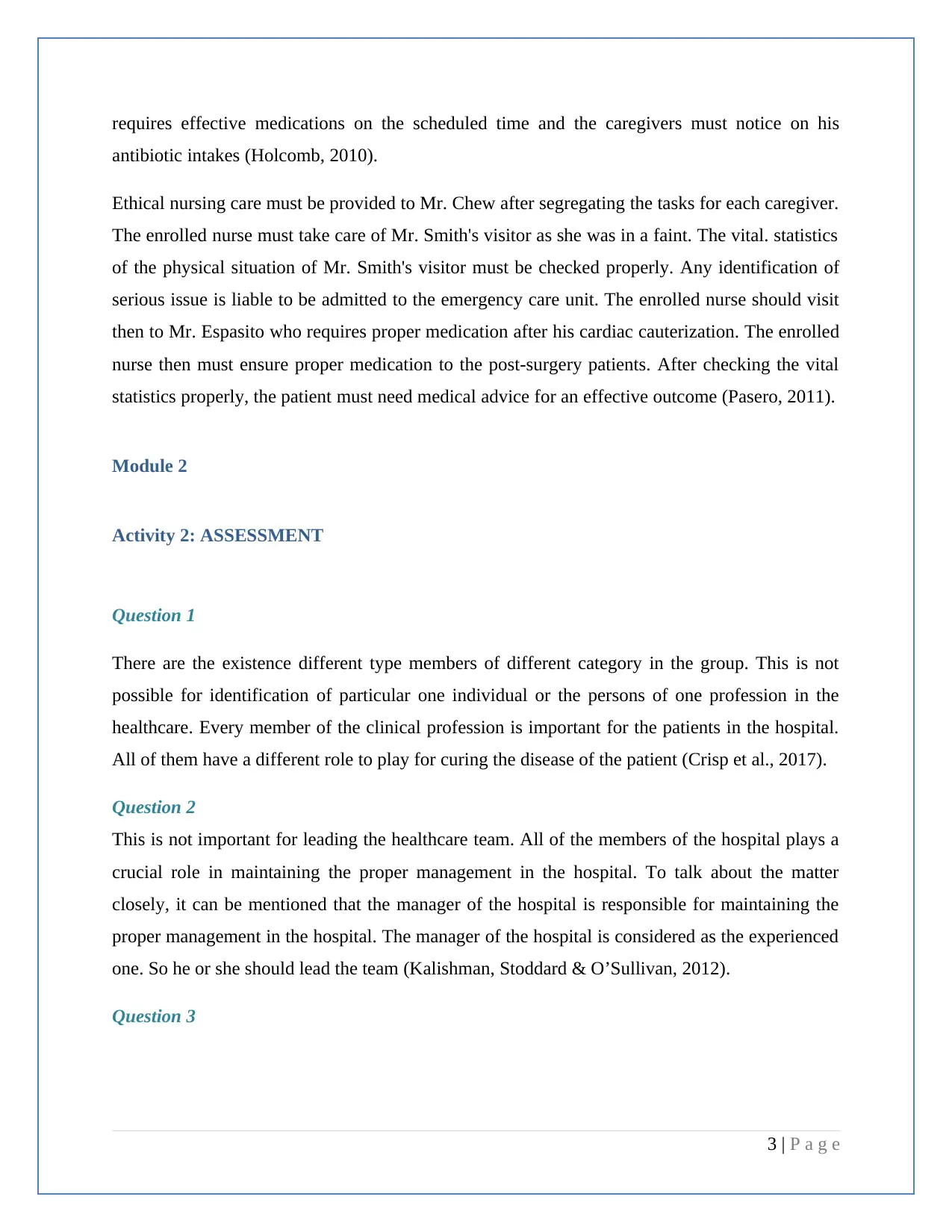
requires effective medications on the scheduled time and the caregivers must notice on his
antibiotic intakes (Holcomb, 2010).
Ethical nursing care must be provided to Mr. Chew after segregating the tasks for each caregiver.
The enrolled nurse must take care of Mr. Smith's visitor as she was in a faint. The vital. statistics
of the physical situation of Mr. Smith's visitor must be checked properly. Any identification of
serious issue is liable to be admitted to the emergency care unit. The enrolled nurse should visit
then to Mr. Espasito who requires proper medication after his cardiac cauterization. The enrolled
nurse then must ensure proper medication to the post-surgery patients. After checking the vital
statistics properly, the patient must need medical advice for an effective outcome (Pasero, 2011).
Module 2
Activity 2: ASSESSMENT
Question 1
There are the existence different type members of different category in the group. This is not
possible for identification of particular one individual or the persons of one profession in the
healthcare. Every member of the clinical profession is important for the patients in the hospital.
All of them have a different role to play for curing the disease of the patient (Crisp et al., 2017).
Question 2
This is not important for leading the healthcare team. All of the members of the hospital plays a
crucial role in maintaining the proper management in the hospital. To talk about the matter
closely, it can be mentioned that the manager of the hospital is responsible for maintaining the
proper management in the hospital. The manager of the hospital is considered as the experienced
one. So he or she should lead the team (Kalishman, Stoddard & O’Sullivan, 2012).
Question 3
3 | P a g e
antibiotic intakes (Holcomb, 2010).
Ethical nursing care must be provided to Mr. Chew after segregating the tasks for each caregiver.
The enrolled nurse must take care of Mr. Smith's visitor as she was in a faint. The vital. statistics
of the physical situation of Mr. Smith's visitor must be checked properly. Any identification of
serious issue is liable to be admitted to the emergency care unit. The enrolled nurse should visit
then to Mr. Espasito who requires proper medication after his cardiac cauterization. The enrolled
nurse then must ensure proper medication to the post-surgery patients. After checking the vital
statistics properly, the patient must need medical advice for an effective outcome (Pasero, 2011).
Module 2
Activity 2: ASSESSMENT
Question 1
There are the existence different type members of different category in the group. This is not
possible for identification of particular one individual or the persons of one profession in the
healthcare. Every member of the clinical profession is important for the patients in the hospital.
All of them have a different role to play for curing the disease of the patient (Crisp et al., 2017).
Question 2
This is not important for leading the healthcare team. All of the members of the hospital plays a
crucial role in maintaining the proper management in the hospital. To talk about the matter
closely, it can be mentioned that the manager of the hospital is responsible for maintaining the
proper management in the hospital. The manager of the hospital is considered as the experienced
one. So he or she should lead the team (Kalishman, Stoddard & O’Sullivan, 2012).
Question 3
3 | P a g e
Paraphrase This Document
Need a fresh take? Get an instant paraphrase of this document with our AI Paraphraser
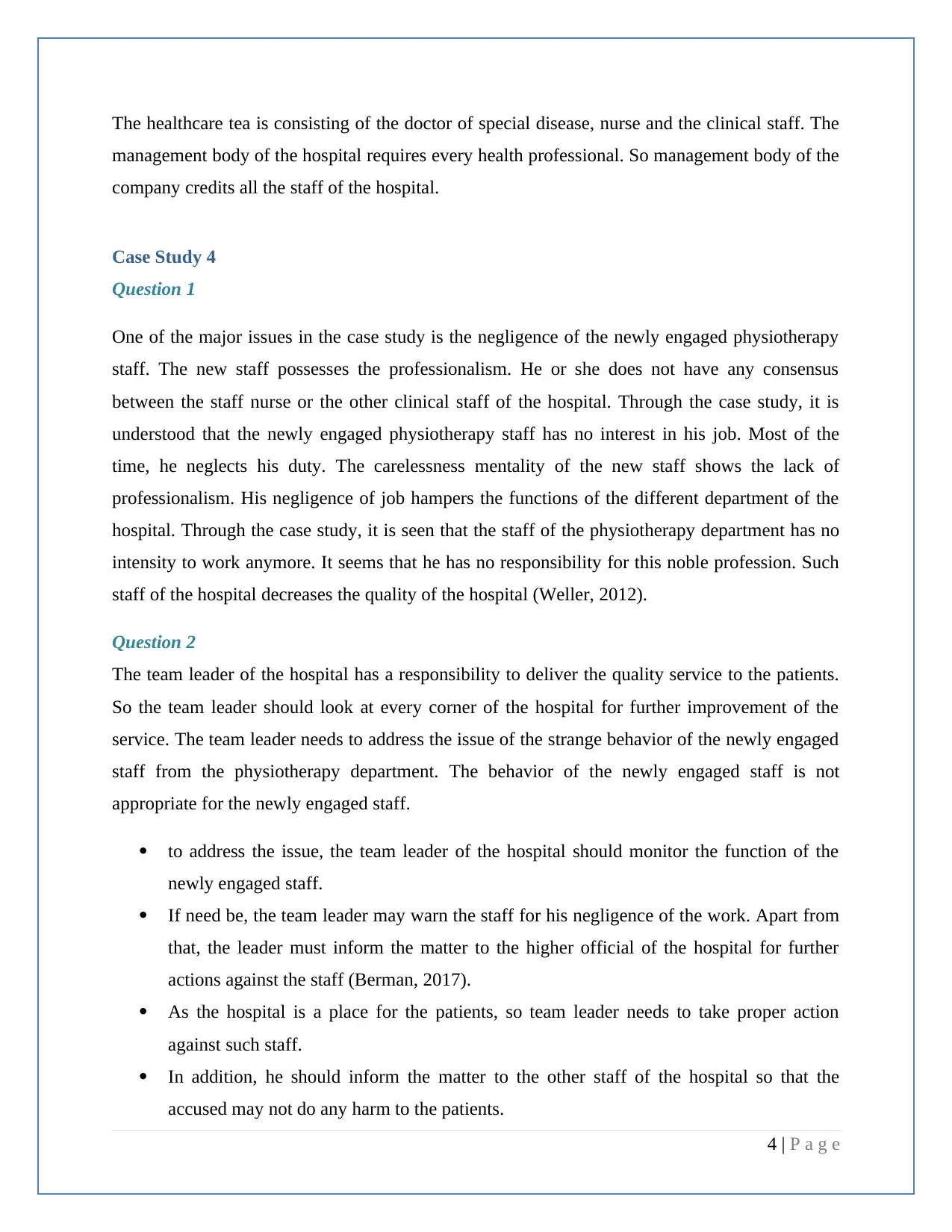
The healthcare tea is consisting of the doctor of special disease, nurse and the clinical staff. The
management body of the hospital requires every health professional. So management body of the
company credits all the staff of the hospital.
Case Study 4
Question 1
One of the major issues in the case study is the negligence of the newly engaged physiotherapy
staff. The new staff possesses the professionalism. He or she does not have any consensus
between the staff nurse or the other clinical staff of the hospital. Through the case study, it is
understood that the newly engaged physiotherapy staff has no interest in his job. Most of the
time, he neglects his duty. The carelessness mentality of the new staff shows the lack of
professionalism. His negligence of job hampers the functions of the different department of the
hospital. Through the case study, it is seen that the staff of the physiotherapy department has no
intensity to work anymore. It seems that he has no responsibility for this noble profession. Such
staff of the hospital decreases the quality of the hospital (Weller, 2012).
Question 2
The team leader of the hospital has a responsibility to deliver the quality service to the patients.
So the team leader should look at every corner of the hospital for further improvement of the
service. The team leader needs to address the issue of the strange behavior of the newly engaged
staff from the physiotherapy department. The behavior of the newly engaged staff is not
appropriate for the newly engaged staff.
to address the issue, the team leader of the hospital should monitor the function of the
newly engaged staff.
If need be, the team leader may warn the staff for his negligence of the work. Apart from
that, the leader must inform the matter to the higher official of the hospital for further
actions against the staff (Berman, 2017).
As the hospital is a place for the patients, so team leader needs to take proper action
against such staff.
In addition, he should inform the matter to the other staff of the hospital so that the
accused may not do any harm to the patients.
4 | P a g e
management body of the hospital requires every health professional. So management body of the
company credits all the staff of the hospital.
Case Study 4
Question 1
One of the major issues in the case study is the negligence of the newly engaged physiotherapy
staff. The new staff possesses the professionalism. He or she does not have any consensus
between the staff nurse or the other clinical staff of the hospital. Through the case study, it is
understood that the newly engaged physiotherapy staff has no interest in his job. Most of the
time, he neglects his duty. The carelessness mentality of the new staff shows the lack of
professionalism. His negligence of job hampers the functions of the different department of the
hospital. Through the case study, it is seen that the staff of the physiotherapy department has no
intensity to work anymore. It seems that he has no responsibility for this noble profession. Such
staff of the hospital decreases the quality of the hospital (Weller, 2012).
Question 2
The team leader of the hospital has a responsibility to deliver the quality service to the patients.
So the team leader should look at every corner of the hospital for further improvement of the
service. The team leader needs to address the issue of the strange behavior of the newly engaged
staff from the physiotherapy department. The behavior of the newly engaged staff is not
appropriate for the newly engaged staff.
to address the issue, the team leader of the hospital should monitor the function of the
newly engaged staff.
If need be, the team leader may warn the staff for his negligence of the work. Apart from
that, the leader must inform the matter to the higher official of the hospital for further
actions against the staff (Berman, 2017).
As the hospital is a place for the patients, so team leader needs to take proper action
against such staff.
In addition, he should inform the matter to the other staff of the hospital so that the
accused may not do any harm to the patients.
4 | P a g e
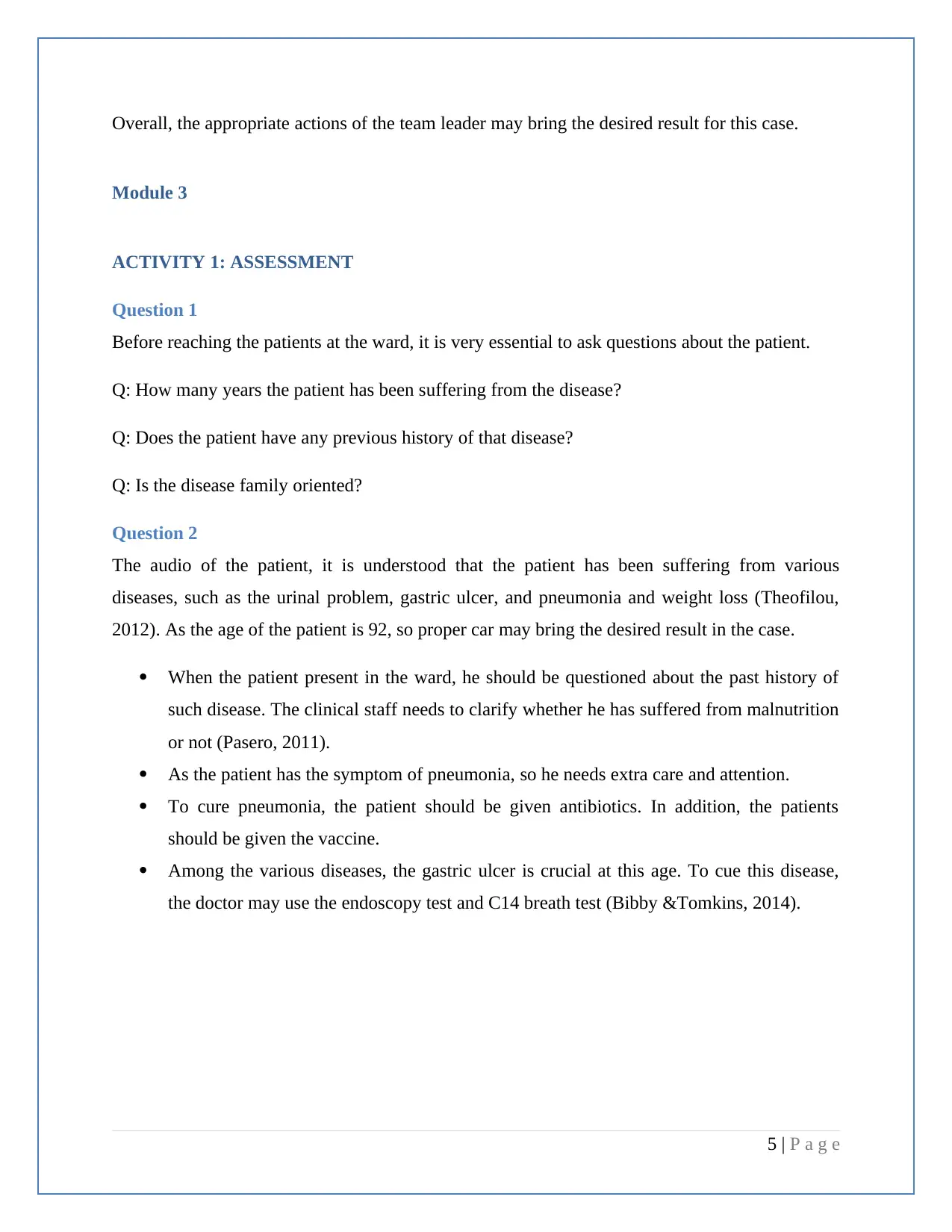
Overall, the appropriate actions of the team leader may bring the desired result for this case.
Module 3
ACTIVITY 1: ASSESSMENT
Question 1
Before reaching the patients at the ward, it is very essential to ask questions about the patient.
Q: How many years the patient has been suffering from the disease?
Q: Does the patient have any previous history of that disease?
Q: Is the disease family oriented?
Question 2
The audio of the patient, it is understood that the patient has been suffering from various
diseases, such as the urinal problem, gastric ulcer, and pneumonia and weight loss (Theofilou,
2012). As the age of the patient is 92, so proper car may bring the desired result in the case.
When the patient present in the ward, he should be questioned about the past history of
such disease. The clinical staff needs to clarify whether he has suffered from malnutrition
or not (Pasero, 2011).
As the patient has the symptom of pneumonia, so he needs extra care and attention.
To cure pneumonia, the patient should be given antibiotics. In addition, the patients
should be given the vaccine.
Among the various diseases, the gastric ulcer is crucial at this age. To cue this disease,
the doctor may use the endoscopy test and C14 breath test (Bibby &Tomkins, 2014).
5 | P a g e
Module 3
ACTIVITY 1: ASSESSMENT
Question 1
Before reaching the patients at the ward, it is very essential to ask questions about the patient.
Q: How many years the patient has been suffering from the disease?
Q: Does the patient have any previous history of that disease?
Q: Is the disease family oriented?
Question 2
The audio of the patient, it is understood that the patient has been suffering from various
diseases, such as the urinal problem, gastric ulcer, and pneumonia and weight loss (Theofilou,
2012). As the age of the patient is 92, so proper car may bring the desired result in the case.
When the patient present in the ward, he should be questioned about the past history of
such disease. The clinical staff needs to clarify whether he has suffered from malnutrition
or not (Pasero, 2011).
As the patient has the symptom of pneumonia, so he needs extra care and attention.
To cure pneumonia, the patient should be given antibiotics. In addition, the patients
should be given the vaccine.
Among the various diseases, the gastric ulcer is crucial at this age. To cue this disease,
the doctor may use the endoscopy test and C14 breath test (Bibby &Tomkins, 2014).
5 | P a g e
⊘ This is a preview!⊘
Do you want full access?
Subscribe today to unlock all pages.

Trusted by 1+ million students worldwide
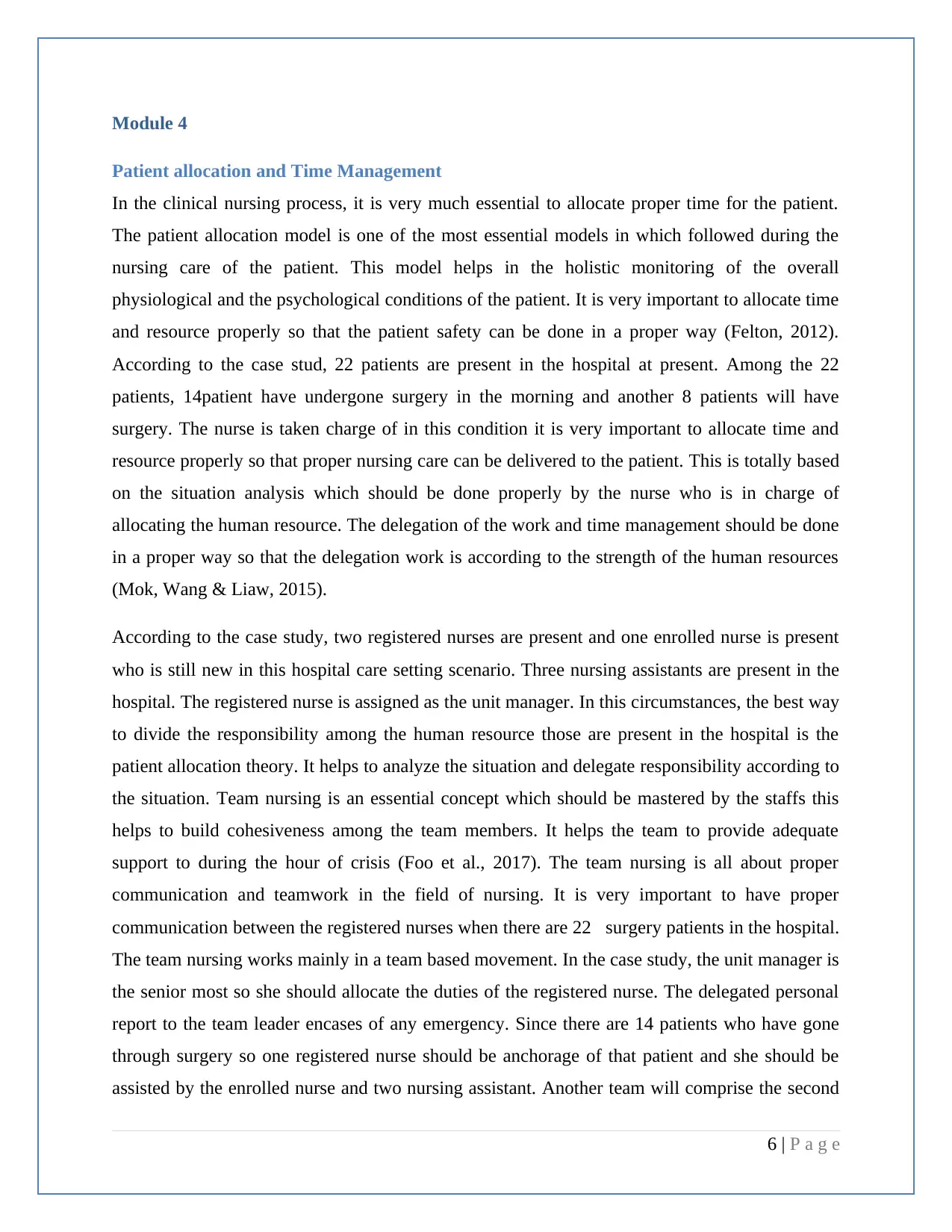
Module 4
Patient allocation and Time Management
In the clinical nursing process, it is very much essential to allocate proper time for the patient.
The patient allocation model is one of the most essential models in which followed during the
nursing care of the patient. This model helps in the holistic monitoring of the overall
physiological and the psychological conditions of the patient. It is very important to allocate time
and resource properly so that the patient safety can be done in a proper way (Felton, 2012).
According to the case stud, 22 patients are present in the hospital at present. Among the 22
patients, 14patient have undergone surgery in the morning and another 8 patients will have
surgery. The nurse is taken charge of in this condition it is very important to allocate time and
resource properly so that proper nursing care can be delivered to the patient. This is totally based
on the situation analysis which should be done properly by the nurse who is in charge of
allocating the human resource. The delegation of the work and time management should be done
in a proper way so that the delegation work is according to the strength of the human resources
(Mok, Wang & Liaw, 2015).
According to the case study, two registered nurses are present and one enrolled nurse is present
who is still new in this hospital care setting scenario. Three nursing assistants are present in the
hospital. The registered nurse is assigned as the unit manager. In this circumstances, the best way
to divide the responsibility among the human resource those are present in the hospital is the
patient allocation theory. It helps to analyze the situation and delegate responsibility according to
the situation. Team nursing is an essential concept which should be mastered by the staffs this
helps to build cohesiveness among the team members. It helps the team to provide adequate
support to during the hour of crisis (Foo et al., 2017). The team nursing is all about proper
communication and teamwork in the field of nursing. It is very important to have proper
communication between the registered nurses when there are 22 surgery patients in the hospital.
The team nursing works mainly in a team based movement. In the case study, the unit manager is
the senior most so she should allocate the duties of the registered nurse. The delegated personal
report to the team leader encases of any emergency. Since there are 14 patients who have gone
through surgery so one registered nurse should be anchorage of that patient and she should be
assisted by the enrolled nurse and two nursing assistant. Another team will comprise the second
6 | P a g e
Patient allocation and Time Management
In the clinical nursing process, it is very much essential to allocate proper time for the patient.
The patient allocation model is one of the most essential models in which followed during the
nursing care of the patient. This model helps in the holistic monitoring of the overall
physiological and the psychological conditions of the patient. It is very important to allocate time
and resource properly so that the patient safety can be done in a proper way (Felton, 2012).
According to the case stud, 22 patients are present in the hospital at present. Among the 22
patients, 14patient have undergone surgery in the morning and another 8 patients will have
surgery. The nurse is taken charge of in this condition it is very important to allocate time and
resource properly so that proper nursing care can be delivered to the patient. This is totally based
on the situation analysis which should be done properly by the nurse who is in charge of
allocating the human resource. The delegation of the work and time management should be done
in a proper way so that the delegation work is according to the strength of the human resources
(Mok, Wang & Liaw, 2015).
According to the case study, two registered nurses are present and one enrolled nurse is present
who is still new in this hospital care setting scenario. Three nursing assistants are present in the
hospital. The registered nurse is assigned as the unit manager. In this circumstances, the best way
to divide the responsibility among the human resource those are present in the hospital is the
patient allocation theory. It helps to analyze the situation and delegate responsibility according to
the situation. Team nursing is an essential concept which should be mastered by the staffs this
helps to build cohesiveness among the team members. It helps the team to provide adequate
support to during the hour of crisis (Foo et al., 2017). The team nursing is all about proper
communication and teamwork in the field of nursing. It is very important to have proper
communication between the registered nurses when there are 22 surgery patients in the hospital.
The team nursing works mainly in a team based movement. In the case study, the unit manager is
the senior most so she should allocate the duties of the registered nurse. The delegated personal
report to the team leader encases of any emergency. Since there are 14 patients who have gone
through surgery so one registered nurse should be anchorage of that patient and she should be
assisted by the enrolled nurse and two nursing assistant. Another team will comprise the second
6 | P a g e
Paraphrase This Document
Need a fresh take? Get an instant paraphrase of this document with our AI Paraphraser
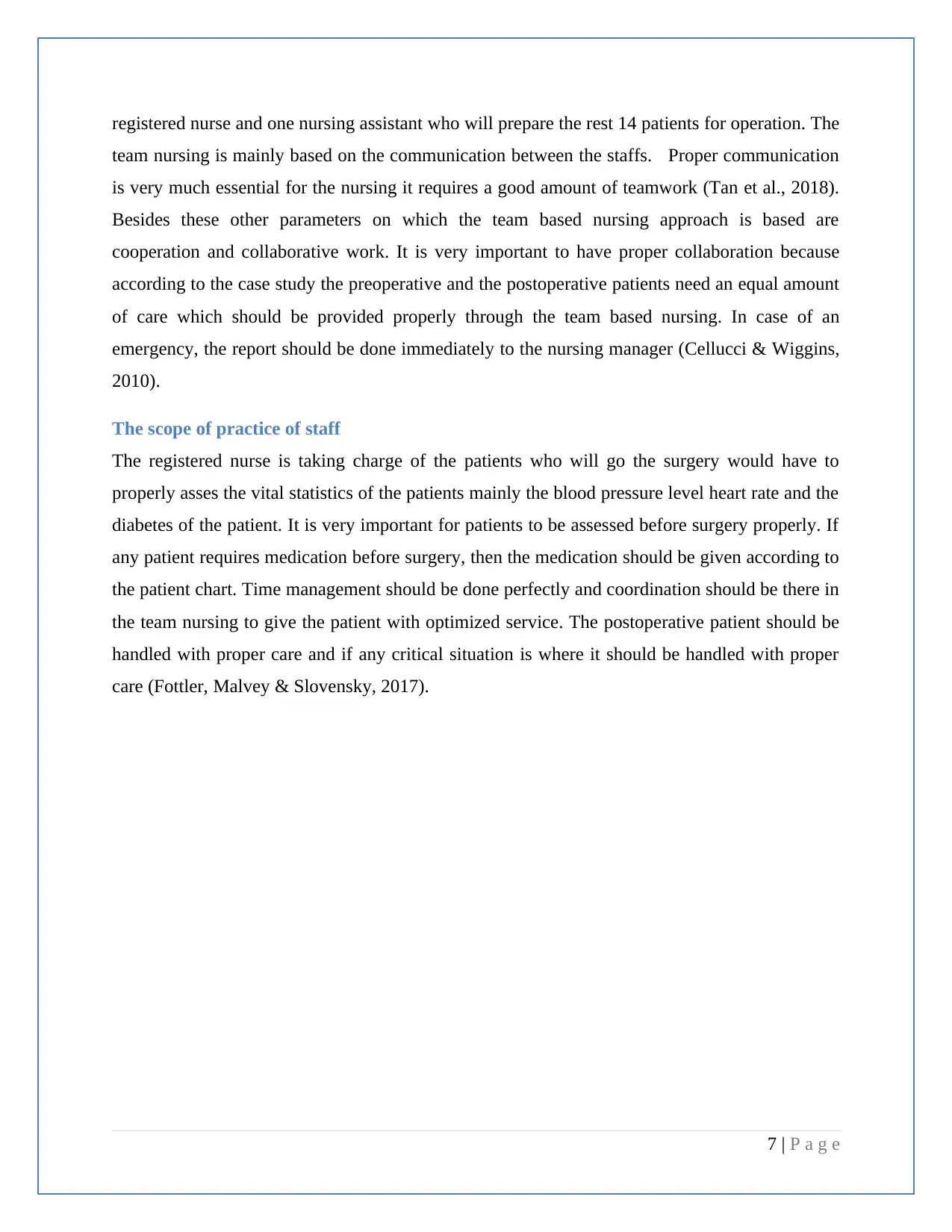
registered nurse and one nursing assistant who will prepare the rest 14 patients for operation. The
team nursing is mainly based on the communication between the staffs. Proper communication
is very much essential for the nursing it requires a good amount of teamwork (Tan et al., 2018).
Besides these other parameters on which the team based nursing approach is based are
cooperation and collaborative work. It is very important to have proper collaboration because
according to the case study the preoperative and the postoperative patients need an equal amount
of care which should be provided properly through the team based nursing. In case of an
emergency, the report should be done immediately to the nursing manager (Cellucci & Wiggins,
2010).
The scope of practice of staff
The registered nurse is taking charge of the patients who will go the surgery would have to
properly asses the vital statistics of the patients mainly the blood pressure level heart rate and the
diabetes of the patient. It is very important for patients to be assessed before surgery properly. If
any patient requires medication before surgery, then the medication should be given according to
the patient chart. Time management should be done perfectly and coordination should be there in
the team nursing to give the patient with optimized service. The postoperative patient should be
handled with proper care and if any critical situation is where it should be handled with proper
care (Fottler, Malvey & Slovensky, 2017).
7 | P a g e
team nursing is mainly based on the communication between the staffs. Proper communication
is very much essential for the nursing it requires a good amount of teamwork (Tan et al., 2018).
Besides these other parameters on which the team based nursing approach is based are
cooperation and collaborative work. It is very important to have proper collaboration because
according to the case study the preoperative and the postoperative patients need an equal amount
of care which should be provided properly through the team based nursing. In case of an
emergency, the report should be done immediately to the nursing manager (Cellucci & Wiggins,
2010).
The scope of practice of staff
The registered nurse is taking charge of the patients who will go the surgery would have to
properly asses the vital statistics of the patients mainly the blood pressure level heart rate and the
diabetes of the patient. It is very important for patients to be assessed before surgery properly. If
any patient requires medication before surgery, then the medication should be given according to
the patient chart. Time management should be done perfectly and coordination should be there in
the team nursing to give the patient with optimized service. The postoperative patient should be
handled with proper care and if any critical situation is where it should be handled with proper
care (Fottler, Malvey & Slovensky, 2017).
7 | P a g e
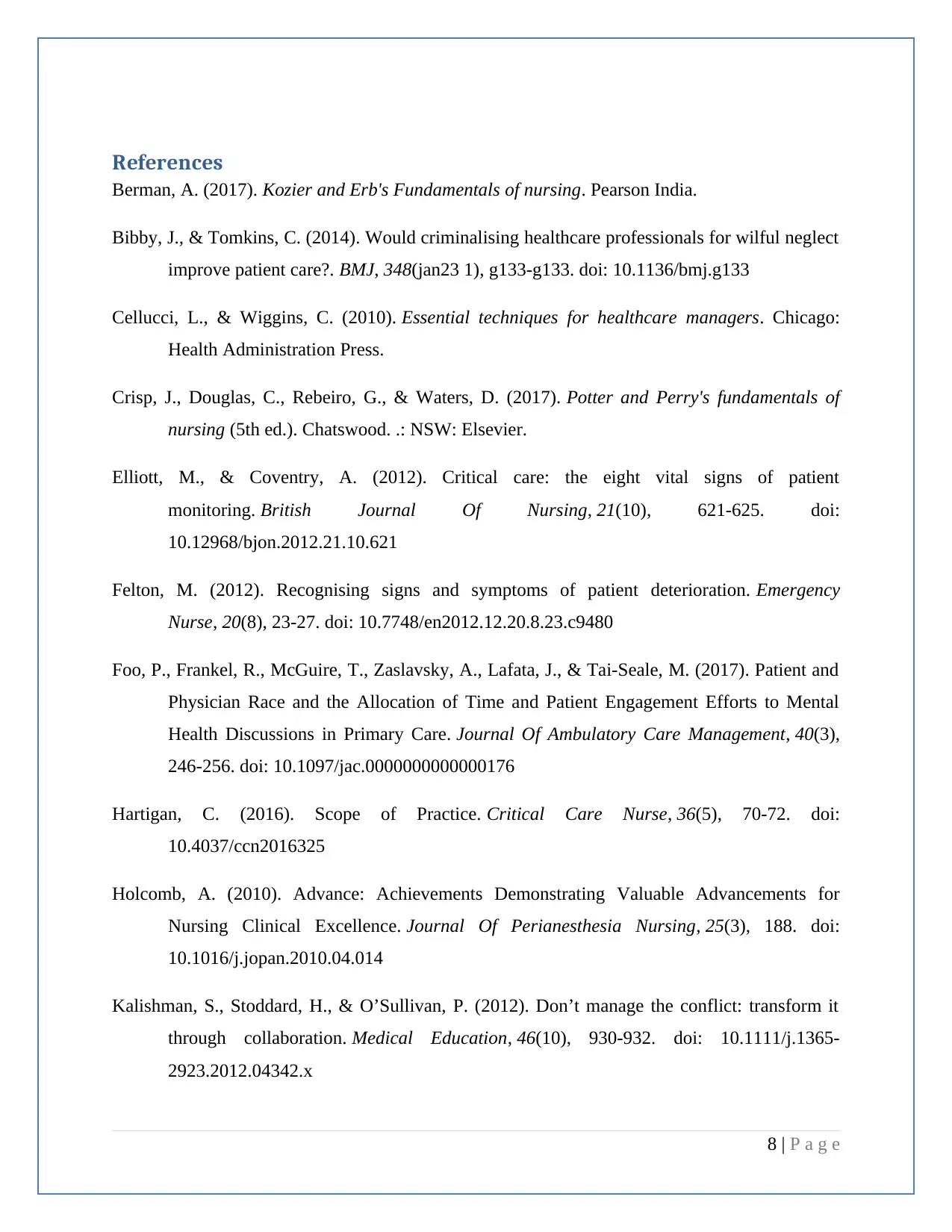
References
Berman, A. (2017). Kozier and Erb's Fundamentals of nursing. Pearson India.
Bibby, J., & Tomkins, C. (2014). Would criminalising healthcare professionals for wilful neglect
improve patient care?. BMJ, 348(jan23 1), g133-g133. doi: 10.1136/bmj.g133
Cellucci, L., & Wiggins, C. (2010). Essential techniques for healthcare managers. Chicago:
Health Administration Press.
Crisp, J., Douglas, C., Rebeiro, G., & Waters, D. (2017). Potter and Perry's fundamentals of
nursing (5th ed.). Chatswood. .: NSW: Elsevier.
Elliott, M., & Coventry, A. (2012). Critical care: the eight vital signs of patient
monitoring. British Journal Of Nursing, 21(10), 621-625. doi:
10.12968/bjon.2012.21.10.621
Felton, M. (2012). Recognising signs and symptoms of patient deterioration. Emergency
Nurse, 20(8), 23-27. doi: 10.7748/en2012.12.20.8.23.c9480
Foo, P., Frankel, R., McGuire, T., Zaslavsky, A., Lafata, J., & Tai-Seale, M. (2017). Patient and
Physician Race and the Allocation of Time and Patient Engagement Efforts to Mental
Health Discussions in Primary Care. Journal Of Ambulatory Care Management, 40(3),
246-256. doi: 10.1097/jac.0000000000000176
Hartigan, C. (2016). Scope of Practice. Critical Care Nurse, 36(5), 70-72. doi:
10.4037/ccn2016325
Holcomb, A. (2010). Advance: Achievements Demonstrating Valuable Advancements for
Nursing Clinical Excellence. Journal Of Perianesthesia Nursing, 25(3), 188. doi:
10.1016/j.jopan.2010.04.014
Kalishman, S., Stoddard, H., & O’Sullivan, P. (2012). Don’t manage the conflict: transform it
through collaboration. Medical Education, 46(10), 930-932. doi: 10.1111/j.1365-
2923.2012.04342.x
8 | P a g e
Berman, A. (2017). Kozier and Erb's Fundamentals of nursing. Pearson India.
Bibby, J., & Tomkins, C. (2014). Would criminalising healthcare professionals for wilful neglect
improve patient care?. BMJ, 348(jan23 1), g133-g133. doi: 10.1136/bmj.g133
Cellucci, L., & Wiggins, C. (2010). Essential techniques for healthcare managers. Chicago:
Health Administration Press.
Crisp, J., Douglas, C., Rebeiro, G., & Waters, D. (2017). Potter and Perry's fundamentals of
nursing (5th ed.). Chatswood. .: NSW: Elsevier.
Elliott, M., & Coventry, A. (2012). Critical care: the eight vital signs of patient
monitoring. British Journal Of Nursing, 21(10), 621-625. doi:
10.12968/bjon.2012.21.10.621
Felton, M. (2012). Recognising signs and symptoms of patient deterioration. Emergency
Nurse, 20(8), 23-27. doi: 10.7748/en2012.12.20.8.23.c9480
Foo, P., Frankel, R., McGuire, T., Zaslavsky, A., Lafata, J., & Tai-Seale, M. (2017). Patient and
Physician Race and the Allocation of Time and Patient Engagement Efforts to Mental
Health Discussions in Primary Care. Journal Of Ambulatory Care Management, 40(3),
246-256. doi: 10.1097/jac.0000000000000176
Hartigan, C. (2016). Scope of Practice. Critical Care Nurse, 36(5), 70-72. doi:
10.4037/ccn2016325
Holcomb, A. (2010). Advance: Achievements Demonstrating Valuable Advancements for
Nursing Clinical Excellence. Journal Of Perianesthesia Nursing, 25(3), 188. doi:
10.1016/j.jopan.2010.04.014
Kalishman, S., Stoddard, H., & O’Sullivan, P. (2012). Don’t manage the conflict: transform it
through collaboration. Medical Education, 46(10), 930-932. doi: 10.1111/j.1365-
2923.2012.04342.x
8 | P a g e
⊘ This is a preview!⊘
Do you want full access?
Subscribe today to unlock all pages.

Trusted by 1+ million students worldwide
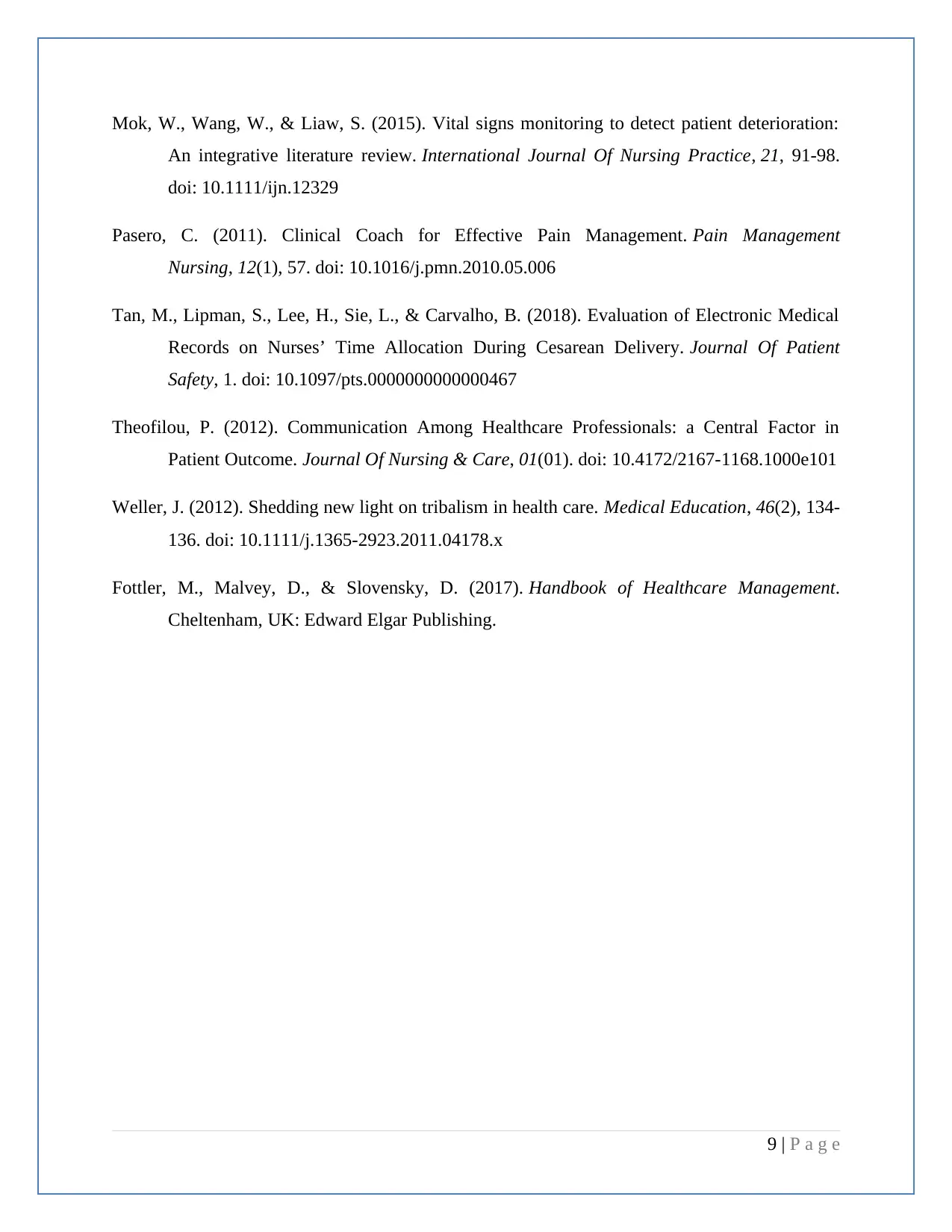
Mok, W., Wang, W., & Liaw, S. (2015). Vital signs monitoring to detect patient deterioration:
An integrative literature review. International Journal Of Nursing Practice, 21, 91-98.
doi: 10.1111/ijn.12329
Pasero, C. (2011). Clinical Coach for Effective Pain Management. Pain Management
Nursing, 12(1), 57. doi: 10.1016/j.pmn.2010.05.006
Tan, M., Lipman, S., Lee, H., Sie, L., & Carvalho, B. (2018). Evaluation of Electronic Medical
Records on Nursesʼ Time Allocation During Cesarean Delivery. Journal Of Patient
Safety, 1. doi: 10.1097/pts.0000000000000467
Theofilou, P. (2012). Communication Among Healthcare Professionals: a Central Factor in
Patient Outcome. Journal Of Nursing & Care, 01(01). doi: 10.4172/2167-1168.1000e101
Weller, J. (2012). Shedding new light on tribalism in health care. Medical Education, 46(2), 134-
136. doi: 10.1111/j.1365-2923.2011.04178.x
Fottler, M., Malvey, D., & Slovensky, D. (2017). Handbook of Healthcare Management.
Cheltenham, UK: Edward Elgar Publishing.
9 | P a g e
An integrative literature review. International Journal Of Nursing Practice, 21, 91-98.
doi: 10.1111/ijn.12329
Pasero, C. (2011). Clinical Coach for Effective Pain Management. Pain Management
Nursing, 12(1), 57. doi: 10.1016/j.pmn.2010.05.006
Tan, M., Lipman, S., Lee, H., Sie, L., & Carvalho, B. (2018). Evaluation of Electronic Medical
Records on Nursesʼ Time Allocation During Cesarean Delivery. Journal Of Patient
Safety, 1. doi: 10.1097/pts.0000000000000467
Theofilou, P. (2012). Communication Among Healthcare Professionals: a Central Factor in
Patient Outcome. Journal Of Nursing & Care, 01(01). doi: 10.4172/2167-1168.1000e101
Weller, J. (2012). Shedding new light on tribalism in health care. Medical Education, 46(2), 134-
136. doi: 10.1111/j.1365-2923.2011.04178.x
Fottler, M., Malvey, D., & Slovensky, D. (2017). Handbook of Healthcare Management.
Cheltenham, UK: Edward Elgar Publishing.
9 | P a g e
1 out of 10
Related Documents
Your All-in-One AI-Powered Toolkit for Academic Success.
+13062052269
info@desklib.com
Available 24*7 on WhatsApp / Email
![[object Object]](/_next/static/media/star-bottom.7253800d.svg)
Unlock your academic potential
Copyright © 2020–2025 A2Z Services. All Rights Reserved. Developed and managed by ZUCOL.





